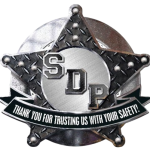Bear pepper spray is an essential tool if you encounter aggressive bears. It’s specially formulated with higher capsaicinoid concentration than personal defense sprays, making it more potent against bears. When using it, aim for when a bear is 20 to 30 feet away and create a cloud by aiming slightly downward. Confirm you’re prepared by checking expiration dates and storing it properly. Regulations vary, so know local laws regarding its use. Bear spray’s effectiveness is over 90% when used correctly, temporarily impairing a bear’s senses and allowing you to escape safely. Discover more to confirm your outdoor adventures remain safe.
What Is Bear Pepper Spray?
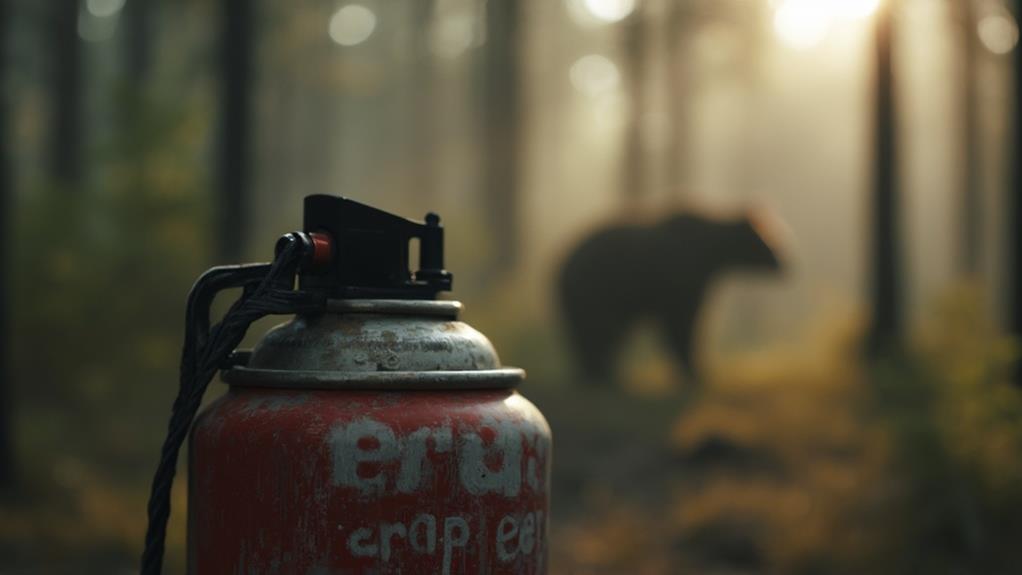
Bear pepper spray is a specially formulated deterrent designed to protect you from aggressive bears in the wild. When you’re exploring bear country, understanding bear behavior is essential for your safety. Bears may become aggressive if they feel threatened or surprised, and that’s where bear pepper spray comes into play.
It’s designed to temporarily impair a bear’s senses, giving you a chance to retreat safely. Before you head out, familiarize yourself with spray regulations. Different areas may have specific rules about carrying and using bear pepper spray. Regulations guarantee the spray is used responsibly and effectively, protecting both you and the bears.
Typically, bear spray contains a higher concentration of capsaicinoids than personal defense sprays, specifically targeting bear aggression. For instance, Grizguard Bear Spray has a 2% capsaicin content, making it one of the most potent options available.
When using bear pepper spray, aim for the bear’s face, creating a cloud of spray between you and the bear. The goal is to disorient and deter the bear without causing lasting harm.
Differences From Personal Defense Spray
While both bear pepper spray and personal defense spray serve as protective tools, they’ve distinct differences that are essential to understand.
First, consider the spray ingredients. Bear spray contains a higher concentration of capsaicinoids, the active ingredients derived from peppers, than personal defense spray. This increased potency is necessary to deter the larger, more robust animals like bears.
In contrast, personal defense sprays are formulated to target human attackers and often contain additional components like UV dye for identification purposes. Additionally, bear sprays like Guard Alaska Bear Spray are environmentally safe, using no flammable or ozone-depleting substances, which is an important consideration for outdoor use.
Next, let’s talk about the range and dispersal. Bear spray is designed to create a larger, more forceful cloud that can reach up to 30-35 feet. This gives you a safer distance from an approaching bear.
On the other hand, personal defense sprays typically have a shorter range, usually around 10 feet, because they’re meant for close encounters.
How Bear Spray Works
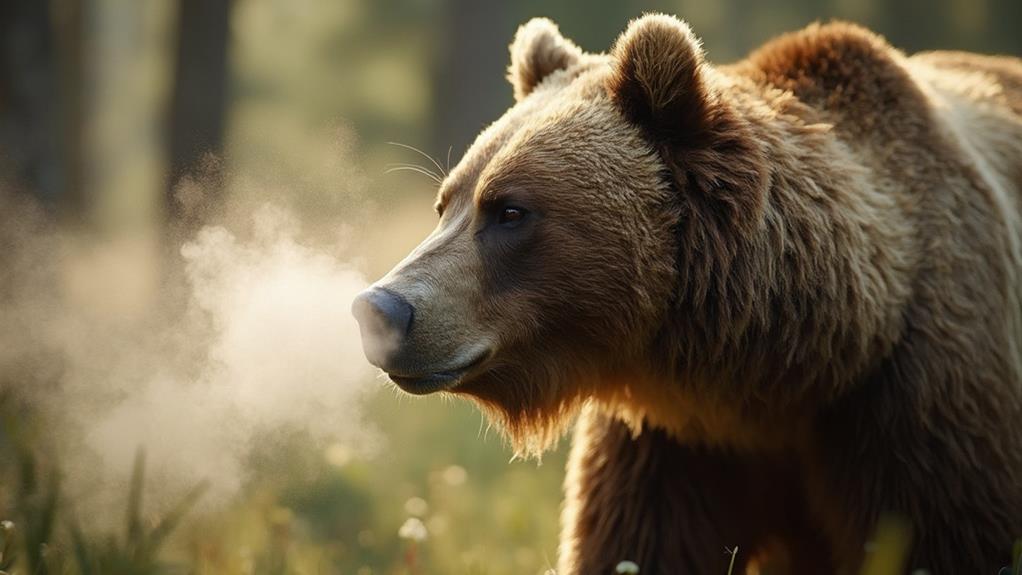
When you’re out in bear country, understanding how bear spray works can be a lifesaver. Bear spray is specifically designed to deter aggressive bear behavior, giving you a vital tool for safety.
The spray chemistry involves capsaicin, the active ingredient derived from chili peppers, which irritates the bear’s eyes, nose, and lungs. This creates a temporary but powerful deterrent, allowing you time to retreat safely. The canister releases a wide, fog-like cloud that can reach up to 30 feet, ensuring that even if a bear is charging, you have a protective zone.
It’s essential to aim slightly downward to create a barrier between you and the bear. For those looking to carry additional protection, multiple bursts per canister are available in Wildfire Pepper Spray Foggers, which are ideal for personal safety. The expansive spray pattern is critical, as bears can run up to 35 miles per hour, so precision and quick action are key.
Bear behavior is unpredictable, but the intense irritation from the spray usually causes the bear to stop, turn away, or retreat. It doesn’t harm the bear permanently, as it’s meant to be a non-lethal method of defense.
Always remember, bear spray is most effective when used correctly, so practice deploying it safely before heading into the wilderness.
Effectiveness Against Bears
Understanding how bear spray works gives you a foundation for evaluating its effectiveness against bears. Bear spray is specifically designed to deter aggressive bear behavior, providing you with a non-lethal means of protection.
It’s essential to know that bear spray isn’t a repellent like bug spray; instead, it’s an irritant that temporarily affects a bear’s senses. When used correctly, it can cause a bear to retreat, giving you time to move to safety.
The effectiveness of bear spray largely depends on the spray range. Most bear sprays cover a distance of 20 to 30 feet. This range helps create a barrier between you and the bear, vital in stopping a charging bear in its tracks.
You should aim low, directing the spray slightly downward to account for the bear’s forward momentum. This guarantees the bear runs through the cloud of spray.
Bear behavior plays a significant role in the outcome. Bears are curious by nature but can become aggressive if they feel threatened. In such situations, deploying bear spray can be a game-changer.
Studies show that when used properly, bear spray is effective in deterring bears over 90% of the time.
Legal Considerations

Maneuvering the legal landscape of bear spray is fundamental for guaranteeing you’re compliant with regulations and safe in your encounters with wildlife. Knowing the regulatory requirements can help you avoid potential legal troubles.
Bear spray is classified differently from regular pepper spray, often carrying specific restrictions. For instance, some areas mandate that bear sprays must be EPA-approved, with clear labeling indicating it’s meant for bears. These sprays usually have a higher capsaicin concentration than personal defense sprays, meeting distinct standards.
Understanding liability issues is essential. If you use bear spray improperly, you might face legal consequences, especially if it results in harm to people or property. In some scenarios, deploying it in a manner not deemed necessary or justified could lead to charges of misuse.
It’s important to comprehend the legal definitions of “appropriate use” where you plan to hike or camp. Always check local laws before carrying bear spray, as they can vary greatly. Some jurisdictions might require permits, while others could have outright bans or limitations.
Being informed about these legal aspects guarantees that your efforts to protect yourself and wildlife stay within the bounds of the law.
Proper Usage Techniques
While it’s crucial to be aware of legal considerations, it’s equally important to know how to use bear spray effectively to guarantee safety. In the wild, usage scenarios can vary, so you must be prepared for different encounters.
When facing a bear, remain calm and assess the situation. If the bear is approaching, hold the canister with both hands, aiming slightly downward. Bears tend to charge with their heads low, so this application method provides optimal coverage.
In practice, bear spray should be used when the bear is within 60 feet—any further, and it mightn’t reach the target. Always spray in short bursts, creating a cloud between you and the bear. This cloud acts as a deterrent, causing the bear to retreat. Remember, the goal isn’t to hit the bear directly but to create a barrier it won’t want to pass through.
Confirm the wind is in your favor; spraying against it can reduce effectiveness. In different usage scenarios, such as windy conditions, adjust your aim accordingly.
Practice these application methods in a safe environment to build confidence and make sure you’re ready when it matters most.
Safety Precautions
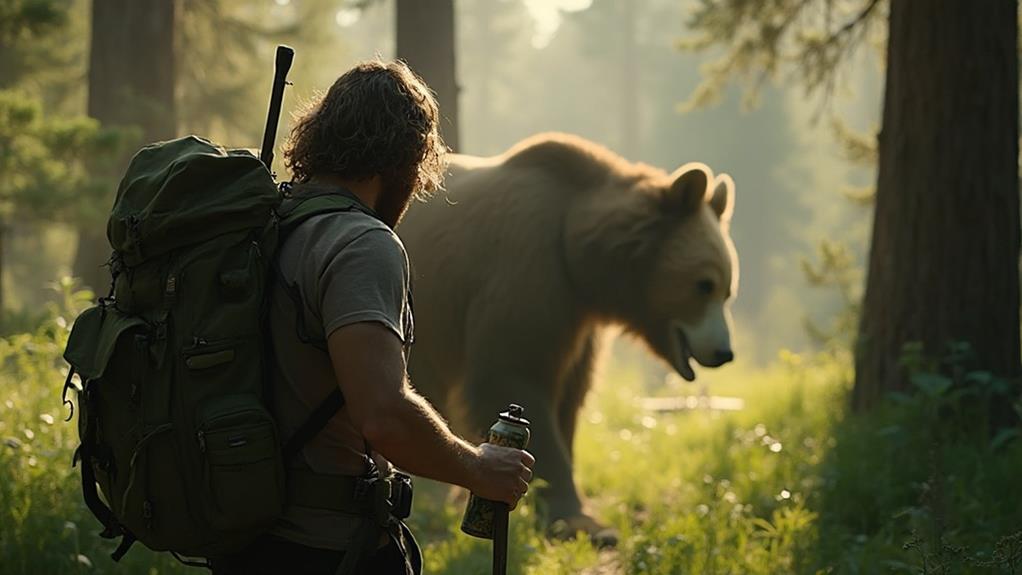
Safety is paramount when handling bear spray, as improper use can lead to unintended harm. You should always familiarize yourself with the product before heading into bear territory.
Practice deploying the spray in a safe, open area to prevent any surprises during an actual encounter. Understand that bear behavior can be unpredictable, and the spray is designed to deter aggressive actions, not to harm the bear permanently.
In encounter scenarios, remain calm and assess the situation. If a bear approaches aggressively, aim slightly downward in front of the bear to create a mist that forms a barrier. Confirm you’re standing upwind to avoid having the spray blow back into your face.
Don’t wait until the bear is too close; deploy when it’s about 25-30 feet away for maximum effectiveness.
Always keep the safety clip on until you’re ready to use it, and never test the spray with the safety removed unless in a real encounter. This prevents accidental discharge that could put you or others at risk.
Storing Bear Spray
Understanding how to store bear spray properly is just as important as knowing how to use it. Effective storage conditions guarantee the spray remains reliable when you need it most.
Start by keeping your bear spray in a cool, dry place. Avoid exposing it to extreme temperatures, both high and low, as this can compromise the canister’s integrity and effectiveness. Ideally, store it at room temperature, away from direct sunlight and heat sources like stoves or heaters.
Don’t forget to check the expiration date regularly. Bear spray typically has a shelf life of three to four years. Using it past its expiration date can result in diminished potency, leaving you vulnerable in a bear encounter. Mark the expiration date on your calendar as a reminder, and replace it before it expires.
Always store bear spray in an easily accessible location when you’re outdoors. In an emergency, you won’t have time to rummage through your backpack. A holster or a dedicated bear spray pocket on your pack can provide quick access.
Choosing the Right Product
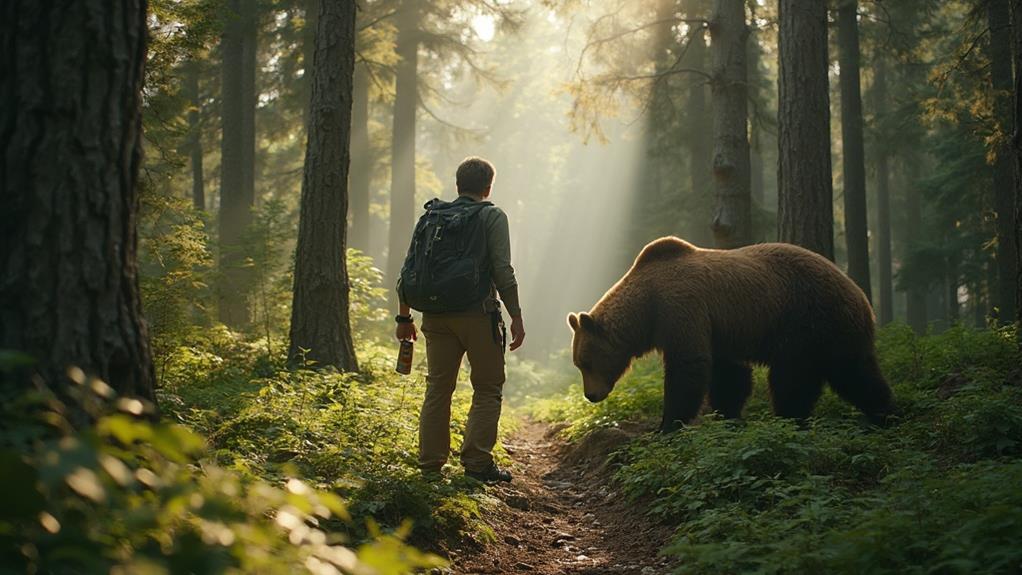
When it comes to selecting bear spray, not all products are created equal. You need to pay attention to specific product features to guarantee you’re well-equipped in a bear encounter.
First, consider the spray range. A good bear spray should have a range of at least 25 feet. This distance gives you ample space to react and create a barrier between you and the bear.
Check the spray duration as well; it should last at least six seconds to provide a continuous, wide-reaching cloud of deterrent.
Look at the canister size. A larger canister might offer more spray time, which can be essential in a tense situation.
Don’t forget about the safety cap. It should be easy to remove quickly, yet secure enough to prevent accidental discharge.
Also, examine the expiration date. Bear spray loses effectiveness over time, so always verify it’s within the recommended period of use.
Additional Safety Tips
In addition to choosing the right bear spray, it’s crucial to follow other safety tips to maximize your protection against bear encounters.
First, always travel in groups, as bears tend to avoid larger gatherings of people. Make noise while hiking—talk, sing, or clap occasionally to alert bears of your presence. This reduces the chance of startling a bear, which is a key bear encounter strategy.
Carry your bear spray in an easily accessible location, such as a holster on your belt or backpack strap. Practice using it before you need it, so you’re prepared in an emergency. Remember, bear spray is a last resort; prevention is your best defense.
Educate yourself about wildlife safety education, learning to recognize bear signs like tracks or scat. Know the difference between black bears and grizzlies, as their behaviors and appropriate responses can differ.
Always secure your food and trash in bear-proof containers, keeping campsites clean and odor-free.
Lastly, if you do encounter a bear, remain calm. Don’t run; instead, back away slowly while speaking softly. These strategies can enhance your safety and preserve the bears’ well-being.
Frequently Asked Questions
Can Bear Pepper Spray Work on Other Wild Animals Besides Bears?
Yes, bear pepper spray can work on other wild animals. When comparing effectiveness, it’s important to understand animal behavior. Different animals may react variably, but the spray’s deterrent properties could still offer you some protection.
What Should You Do if Bear Spray Accidentally Discharges in a Car?
Congratulations, you’ve turned your car into a spicy sauna! First, prioritize safety precautions by ventilating. Open all doors, let air circulate, and then tackle cleaning methods with soapy water or vinegar to neutralize the irritant.
Is There a Specific Expiration Date for Bear Pepper Spray?
Yes, bear pepper spray’s shelf life is typically three to four years. Check the canister for an expiration date. Proper storage conditions, like keeping it cool and dry, can help maintain its effectiveness until then.
How Does Weather Affect the Performance of Bear Spray?
When it rains, it pours—weather impacts bear spray effectiveness. High temperatures can cause pressure loss, while cold temps may reduce spray range. Always check temperature impact before heading out, ensuring your bear spray works as intended.
Can Bear Spray Be Taken on International Camping Trips?
When planning international camping trips, you’ve got to check international regulations on pepper spray legality. Some countries restrict or ban it, so make certain you comply to avoid issues at customs or during your outdoor adventures.



